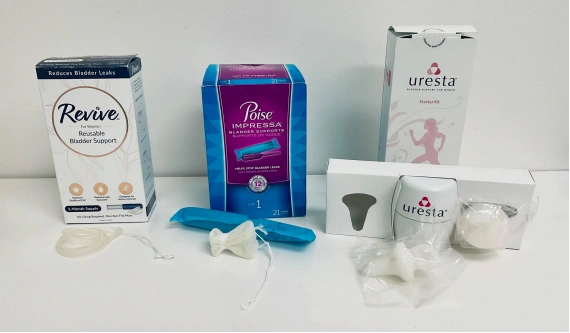Pelvic Support Devices for Prolapse and Bladder Leaks
Prolapse is a pelvic floor condition in which there is increased movement of the vaginal walls which can lead to reduced support for the bladder or colon and can cause symptoms including bladder leaks with activity, heaviness, or a sensation of bulging in the vaginal region.
When it comes to pelvic floor issues like leakage and prolapse, I always recommend seeing a pelvic floor physical therapist to problem solve why they are happening. One of the misconceptions about prolapse and leakage is that they are solely caused by weakness of the pelvic floor muscles and can always be solved by exercise alone. While pelvic floor exercises, manual therapy work, and a comprehensive strength and mobility program can resolve these issues for many women, there are many other factors that can affect leakage and prolapse.
For some women their prolapse or leakage is caused by laxity—increased mobility— in the connective tissue and ligaments that support their vaginal wall, bladder, or urethra. In these cases, exercise alone may not be enough to resolve symptoms. When this is the case, we may recommend medical devices such as pessaries or external support garments to support the pelvic floor, vaginal canal, and urethra. These devices can reduce prolapse symptoms or bladder leakage with activity (stress urinary incontinence) and offer more immediate relief while we work on strengthening and improving movement patterns. Think of these devices as a splint for the pelvic floor.
Pessaries
Pessaries are a medical device that is inserted in the vaginal canal to help support the vaginal walls. Some patients are worried that their pelvic floor will be weakened or otherwise negatively impacted by using a pessary, but evidence shows that pessaries do not cause pelvic floor weakness and can actually allow the pelvic floor muscles to be able to function better by providing additional support.
We’ve discussed fitted pessaries in a previous blog post here: Pessary Fitting & Management. A fitted pessary comes in a variety of shapes and sizes, although the most common shapes are a ring and a cube. These pessaries are chosen after a vaginal exam with your provider that involves a measurement of your vaginal canal and pelvic floor as well as any prolapse to determine the best type and size for you.
Over the Counter Pessaries
There are a variety of over the counter options that are currently available and don’t require a prescription or provider fitting, although we still recommend consulting a pelvic floor physical therapist for guidance.

Impressa
The Poise Impressa is a single use pessary that comes in an applicator like a tampon. Once inserted within the vaginal canal it provides a slight lift to the bladder and slightly compresses the urethra to prevent or reduce leakage. It comes in 3 sizes and is made of a silicone core covered with a non-absorbent mesh fabric and can be used for up to 12 hours at a time. I often recommended this as a trial of whether a pessary may be helpful or for for women who have occasional leakage or prolapse symptoms and would like a product that is only needed occasionally,
Uresta
The Uresta is a reusable pessary that can be used for up to a year, and should be removed and washed daily. It has a sizing kit that has 3 sizes that allow women to determine their best fit with additional sizes available if needed. It is firmer than the Revive bladder support and so may provide more support, but also needs to be fit more specifically. In a 2017 study 66.7% of women who used the Uresta had at least a 50% reduction in leakage.
Revive Bladder Support
The revive bladder support is a reusable silicone pessary that can be used for up to 30 days and comes with an applicator that can help with insertion as well as a set of 30 strings that can be used to help with removal. It comes in one size which fits most women and is shaped like a ring with an additional support that sits against the urethra and can help give additional support for women experiencing leakage.
External Support Garments
While an internal pessary typically gives the strongest support for prolapse, external support garments can be a great option based on personal needs or comfort. garments often function like a sling under the pelvic floor providing light compression and lift. Some designs include abdominal compression with a gentle upward gradient, helping redirect pressure away from the pelvic floor. Although research on these types of garments is still emerging, some studies have found that pelvic support garments can slightly lift the pelvic floor and bladder into a more optimal position which can reduce leakage and prolapse symptoms. 2 In one study that compared shaper brand pelvic support underwear and pelvic floor strengthening for women with stress incontinence, 73.3% of women using the pelvic support wear and 74% of the women undergoing pelvic floor muscle training had at least 50% improvement in leakage while only 25% of women who received no intervention had improvement in symptom. 3 Some options are also specifically designed to provide compression to the pelvic floor and reduce swelling and issues like vulvar varicosities.
Some common brands we recommend include:
Designed for everyday use, Hem Support Wear offers high-waisted pelvic floor support underwear featuring a patent-pending support hammock to provide gentle compression and lift for the pelvic region and can be helpful for pelvic pain and prolapse.
LoveSteady’s Support Bloomers are specifically designed for maternity and postpartum support. They feature a “bottoms up” approach with a supportive hammock for the pelvic floor.
SRC Restore Shorts are designed to support the pelvic floor and assist with recovery. They offer compression support for prolapse and incontinence as well as vulvar varicosities or swelling.
My Pelvic Bra is a support garment that can be worn over underwear and provides discreet support specifically for the pelvic region.
Although not all support garments have not been independently researched, they can be valuable adjunctives to pelvic floor physical therapy. They can provide immediate relief and support while we work on long-term strength and movement strategies. As always, I recommend working with a medical provider or pelvic floor physical therapist to find the best solution for your unique needs—and to use support devices in combination with physical therapy for the best outcomes.
Written by: Dr. Carol Beck, PT, DPT

